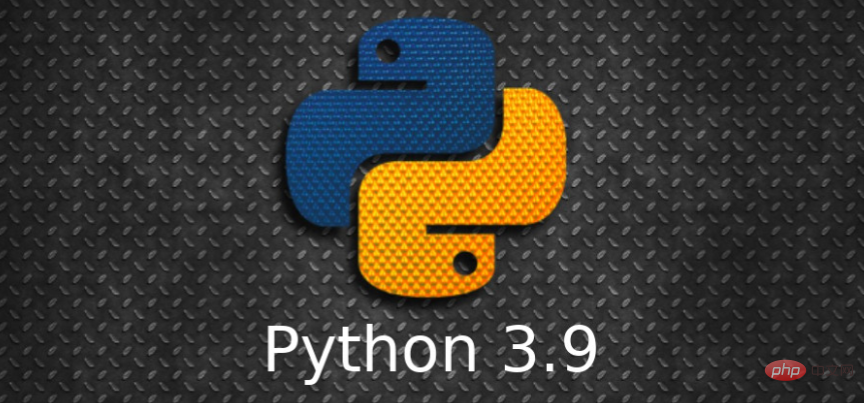今天python教程栏目介绍Python 3.9。

Python 3.9,来了!
过去一年,来自世界各地的开发者们一直在致力于Python3.8的改进。Python 3.9 beta版本已经存在了一段时间,第一个正式版本于2020年10月5日发布。
每个Python版本都包含新开发和改进的功能,Python 3.9也不例外。

【python学习交流群】
下面介绍Python 3.9几个主要的新功能。
1. 字典(合并&更新)运算符
字典是Python中最基础的数据结构之一,并且随着python版本的迭代,性能得到不断地优化。
Python3.9中,合并(|)和更新(|=)运算符已添加到dict类中。这些更新完善了现有的dict.update和{** d1,** d2}方法。
传统合并字典的方法:
>>> pycon = {2016: "Portland", 2018: "Cleveland"} # 字典1>>> europython = {2017: "Rimini", 2018: "Edinburgh", 2019: "Basel"} # 字典2# 方法一>>> {**pycon, **europython}{2016: 'Portland', 2018: 'Edinburgh', 2017: 'Rimini', 2019: 'Basel'}#方法二>>> merged = pycon.copy>>> for key, value in europython.items:... merged[key] = value...>>> merged{2016: 'Portland', 2018: 'Edinburgh', 2017: 'Rimini', 2019: 'Basel'}复制代码
这两种方法都合并了字典而不更改原始数据。请注意,字典1中“Cleveland”已被合并的字典2中“Edinburgh”覆盖。
你也可以更新字典1:
>>> pycon.update(europython)>>> pycon{2016: 'Portland', 2018: 'Edinburgh', 2017: 'Rimini', 2019: 'Basel'}复制代码
新版本的Python引入了两个新的字典运算符:合并(|)和更新(|=)。你可以使用|合并两个字典,而|=用于更新字典:
>>> pycon = {2016: "Portland", 2018: "Cleveland"}>>> europython = {2017: "Rimini", 2018: "Edinburgh", 2019: "Basel"}>>> pycon | europython # 合并{2016: 'Portland', 2018: 'Edinburgh', 2017: 'Rimini', 2019: 'Basel'}>>> pycon |= europython # 更新>>> pycon{2016: 'Portland', 2018: 'Edinburgh', 2017: 'Rimini', 2019: 'Basel'}复制代码
d1|d2和{** d1,** d2}的作用类似,都用于合并字典取并集,遇到相同key,后者会将前者覆盖。
使用|的优势之一是它适用于类似字典的类型,并在合并后保持原来的类型:
>>> from collections import defaultdict>>> europe = defaultdict(lambda: "", {"Norway": "Oslo", "Spain": "Madrid"})>>> africa = defaultdict(lambda: "", {"Egypt": "Cairo", "Zimbabwe": "Harare"})>>> europe | africadefaultdict(<function <lambda> at 0x7f0cb42a6700>,{'Norway': 'Oslo', 'Spain': 'Madrid', 'Egypt': 'Cairo', 'Zimbabwe': 'Harare'})>>> {**europe, **africa}{'Norway': 'Oslo', 'Spain': 'Madrid', 'Egypt': 'Cairo', 'Zimbabwe': 'Harare'}复制代码
|=的作用是更新字典,类似于.update:
>>> libraries = {... "collections": "Container datatypes",... "math": "Mathematical functions",... }>>> libraries |= {"zoneinfo": "IANA time zone support"}>>> libraries{'collections': 'Container datatypes', 'math': 'Mathematical functions','zoneinfo': 'IANA time zone support'}复制代码
|=还可以将类似字典的数据结构用于更新:
>>> libraries |= [("graphlib", "Functionality for graph-like structures")]>>> libraries{'collections': 'Container datatypes', 'math': 'Mathematical functions','zoneinfo': 'IANA time zone support','graphlib': 'Functionality for graph-like structures'}复制代码
2. 删除字符串前缀和后缀
在Python 3.9中,可以使用.removeprefix和.removesuffix分别删除字符串的开头或结尾:
>>> "three cool features in Python".removesuffix(" Python")'three cool features in'>>> "three cool features in Python".removeprefix("three ")'cool features in Python'>>> "three cool features in Python".removeprefix("Something else")'three cool features in Python'复制代码
有人会说.strip方法也可以呀,但是该方法会出现误删操作:
>>> "three cool features in Python".strip(" Python")'ree cool features i'复制代码
可以看到,明明想删掉结尾的单词python,但是开头的there也被删除了一部分-Th。
所以.removeprefix和.removesuffix可能更精准一些。
3. zoneinfo时区模块
zoneinfo是python3.9新引入的模块,zoneinfo可以访问Internet号码分配机构(IANA)时区数据库。IANA每年都会多次更新其数据库,这是时区信息的最权威来源。
使用zoneinfo,可以获得数据库中描述任何时区的对象:
>>> from zoneinfo import ZoneInfo>>> ZoneInfo("America/Vancouver")zoneinfo.ZoneInfo(key='America/Vancouver')
>>> from zoneinfo import ZoneInfo>>> from datetime import datetime, timedelta>>> # 夏令时>>> dt = datetime(2020, 10, 31, 12, tzinfo=ZoneInfo("America/Los_Angeles"))>>> print(dt)2020-10-31 12:00:00-07:00>>> dt.tzname'PDT'>>> # 标准时间>>> dt += timedelta(days=7)>>> print(dt)2020-11-07 12:00:00-08:00>>> print(dt.tzname)PST复制代码
4. 内置集合类型用于类型提示
在类型提示中,现在可以将内置集合类型(例如list和dict)用作泛型类型,而不必从typing中导入相应的大写类型(例如List或Dict)。
def greet_all(names: list[str]) -> None:for name in names:print("Hello", name)复制代码
5. 拓扑排序
Python 3.9添加了一个新的模块graphlib,其中包含graphlib.TopologicalSorter类,以提供执行拓扑排序的功能。
>>> dependencies = {... "realpython-reader": {"feedparser", "html2text"},... "feedparser": {"sgmllib3k"},... }...>>> from graphlib import TopologicalSorter>>> ts = TopologicalSorter(dependencies)>>> list(ts.static_order)['html2text', 'sgmllib3k', 'feedparser', 'realpython-reader']复制代码
6. 最小公倍数(LCM)
Python长期以来一直具有用于计算两个数字的最大公约数(GCD)的功能:
>>> import math>>> math.gcd(49, 14)7复制代码
最小公倍数(LCM)与最大公约数(GCD)有关,可以根据GCD定义LCM:
>>> def lcm(num1, num2):... if num1 == num2 == 0:... return 0... return num1 * num2 // math.gcd(num1, num2)...>>> lcm(49, 14)98复制代码
在Python 3.9中,不再需要定义自己的LCM函数,它新增了计算最小公倍数功能:
>>> import math>>> math.lcm(49, 14)98复制代码
7. 更强大的Python解析器
Python 3.9最酷的功能之一是大家在日常编程中不会注意到的功能,那就是解析器的更新。解析器是Python解释器的基本组件。在最新版本中,解析器已重新构建。
Python之前一直使用LL(1)解析器将源代码解析为解析树。你可以将LL(1)解析器视为一次读取一个字符,并解释源代码而无需回溯的解析器。
新解释器是基于PEG(parsing expression grammar)实现的,并非LL(1)。新解析器的性能可以与旧解析器媲美,在设计新语言功能时,PEG比LL(1)更灵活。
在整个标准库中,PEG解析器稍快一些,然而也使用了更多的内存。实际上,使用新解析器时,很难能感知到性能的好坏。
相关免费学习推荐:python教程(视频)
以上是终于介绍Python 3.9的详细内容。更多信息请关注PHP中文网其他相关文章!
 Python和时间:充分利用您的学习时间Apr 14, 2025 am 12:02 AM
Python和时间:充分利用您的学习时间Apr 14, 2025 am 12:02 AM要在有限的时间内最大化学习Python的效率,可以使用Python的datetime、time和schedule模块。1.datetime模块用于记录和规划学习时间。2.time模块帮助设置学习和休息时间。3.schedule模块自动化安排每周学习任务。
 Python:游戏,Guis等Apr 13, 2025 am 12:14 AM
Python:游戏,Guis等Apr 13, 2025 am 12:14 AMPython在游戏和GUI开发中表现出色。1)游戏开发使用Pygame,提供绘图、音频等功能,适合创建2D游戏。2)GUI开发可选择Tkinter或PyQt,Tkinter简单易用,PyQt功能丰富,适合专业开发。
 Python vs.C:申请和用例Apr 12, 2025 am 12:01 AM
Python vs.C:申请和用例Apr 12, 2025 am 12:01 AMPython适合数据科学、Web开发和自动化任务,而C 适用于系统编程、游戏开发和嵌入式系统。 Python以简洁和强大的生态系统着称,C 则以高性能和底层控制能力闻名。
 2小时的Python计划:一种现实的方法Apr 11, 2025 am 12:04 AM
2小时的Python计划:一种现实的方法Apr 11, 2025 am 12:04 AM2小时内可以学会Python的基本编程概念和技能。1.学习变量和数据类型,2.掌握控制流(条件语句和循环),3.理解函数的定义和使用,4.通过简单示例和代码片段快速上手Python编程。
 Python:探索其主要应用程序Apr 10, 2025 am 09:41 AM
Python:探索其主要应用程序Apr 10, 2025 am 09:41 AMPython在web开发、数据科学、机器学习、自动化和脚本编写等领域有广泛应用。1)在web开发中,Django和Flask框架简化了开发过程。2)数据科学和机器学习领域,NumPy、Pandas、Scikit-learn和TensorFlow库提供了强大支持。3)自动化和脚本编写方面,Python适用于自动化测试和系统管理等任务。
 您可以在2小时内学到多少python?Apr 09, 2025 pm 04:33 PM
您可以在2小时内学到多少python?Apr 09, 2025 pm 04:33 PM两小时内可以学到Python的基础知识。1.学习变量和数据类型,2.掌握控制结构如if语句和循环,3.了解函数的定义和使用。这些将帮助你开始编写简单的Python程序。
 如何在10小时内通过项目和问题驱动的方式教计算机小白编程基础?Apr 02, 2025 am 07:18 AM
如何在10小时内通过项目和问题驱动的方式教计算机小白编程基础?Apr 02, 2025 am 07:18 AM如何在10小时内教计算机小白编程基础?如果你只有10个小时来教计算机小白一些编程知识,你会选择教些什么�...
 如何在使用 Fiddler Everywhere 进行中间人读取时避免被浏览器检测到?Apr 02, 2025 am 07:15 AM
如何在使用 Fiddler Everywhere 进行中间人读取时避免被浏览器检测到?Apr 02, 2025 am 07:15 AM使用FiddlerEverywhere进行中间人读取时如何避免被检测到当你使用FiddlerEverywhere...


热AI工具

Undresser.AI Undress
人工智能驱动的应用程序,用于创建逼真的裸体照片

AI Clothes Remover
用于从照片中去除衣服的在线人工智能工具。

Undress AI Tool
免费脱衣服图片

Clothoff.io
AI脱衣机

AI Hentai Generator
免费生成ai无尽的。

热门文章

热工具

安全考试浏览器
Safe Exam Browser是一个安全的浏览器环境,用于安全地进行在线考试。该软件将任何计算机变成一个安全的工作站。它控制对任何实用工具的访问,并防止学生使用未经授权的资源。

EditPlus 中文破解版
体积小,语法高亮,不支持代码提示功能

DVWA
Damn Vulnerable Web App (DVWA) 是一个PHP/MySQL的Web应用程序,非常容易受到攻击。它的主要目标是成为安全专业人员在合法环境中测试自己的技能和工具的辅助工具,帮助Web开发人员更好地理解保护Web应用程序的过程,并帮助教师/学生在课堂环境中教授/学习Web应用程序安全。DVWA的目标是通过简单直接的界面练习一些最常见的Web漏洞,难度各不相同。请注意,该软件中

Dreamweaver CS6
视觉化网页开发工具

适用于 Eclipse 的 SAP NetWeaver 服务器适配器
将Eclipse与SAP NetWeaver应用服务器集成。






